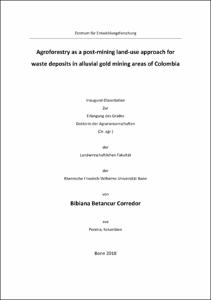Betancur Corredor, Bibiana: Agroforestry as a post-mining land-use approach for waste deposits in alluvial gold mining areas of Colombia. - Bonn, 2018. - Dissertation, Rheinische Friedrich-Wilhelms-Universität Bonn.
Online-Ausgabe in bonndoc: https://nbn-resolving.org/urn:nbn:de:hbz:5n-50915
Online-Ausgabe in bonndoc: https://nbn-resolving.org/urn:nbn:de:hbz:5n-50915
@phdthesis{handle:20.500.11811/7349,
urn: https://nbn-resolving.org/urn:nbn:de:hbz:5n-50915,
author = {{Bibiana Betancur Corredor}},
title = {Agroforestry as a post-mining land-use approach for waste deposits in alluvial gold mining areas of Colombia},
school = {Rheinische Friedrich-Wilhelms-Universität Bonn},
year = 2018,
month = may,
note = {Alluvial gold mining generates a vast amount of extractive waste that completely covers the natural soil, destroys riparian ecosystems, and negatively impacts river beds and valleys. Since 2002, a gold mining company has striven to create agroforestry plots in the waste deposits as a post-mining management approach, where agricultural crops and livestock are combined to complement reforestation in the area. This research aims at supporting reclamation of waste deposits by providing a comprehensive understanding of processes to manage the transition of nutrient-poor and acidic deposition sites towards productive agroforestry-based systems. Major components of this research comprise (i) an analysis of environmental and social challenges of the gold mining sector in Colombia, and its potential opportunities to add value to affected communities, (ii) an assessment of management practices and decision-making processes of the farmers working on reclamation areas, (iii) an analysis of the sources of variability of waste deposits from the perspective of soil development and vegetation succession, (iv) an analysis of spatial variability of the physicochemical properties of waste deposits with a spatially explicit management scheme, and (v) an assessment of vegetation recovery in terms of biomass and plant community composition.
Farmers who are currently working on areas undergoing reclamation rely mostly on their own local knowledge to respond to the challenges that the heavily disturbed conditions of the area pose to crop establishment. Therefore, increasing their awareness of the inherent heterogeneity of their fields, as well as the interdependencies between management practices and improvement of soil fertility, may increase the productivity of their farms. The analysis of sources of variability of the waste deposits generated by alluvial gold mining revealed that these deposits are primarily influenced by the parent material of the alluvial gold deposits and by the technology used for gold mining (bucket or suction dredges), which define the type of deposit formed (gravel or sand). Waste deposits can provide essential functions for rural areas such as woody biomass production and crop establishment if deposits are managed according to a specific purpose, and crop selection for each deposit is done based on physicochemical and structural soil properties. This finding is echoed by the spatial assessment of vegetation reestablishment through the combination of remote sensing with machine-learning techniques that show a high spatial variability of textural properties and nutrient contents of the deposits. A management approach is proposed with the use of delineated management zones, which can lead to an overall increased productivity by developing strategies suitable to the characteristics of each field and its potential uses.},
url = {https://hdl.handle.net/20.500.11811/7349}
}
urn: https://nbn-resolving.org/urn:nbn:de:hbz:5n-50915,
author = {{Bibiana Betancur Corredor}},
title = {Agroforestry as a post-mining land-use approach for waste deposits in alluvial gold mining areas of Colombia},
school = {Rheinische Friedrich-Wilhelms-Universität Bonn},
year = 2018,
month = may,
note = {Alluvial gold mining generates a vast amount of extractive waste that completely covers the natural soil, destroys riparian ecosystems, and negatively impacts river beds and valleys. Since 2002, a gold mining company has striven to create agroforestry plots in the waste deposits as a post-mining management approach, where agricultural crops and livestock are combined to complement reforestation in the area. This research aims at supporting reclamation of waste deposits by providing a comprehensive understanding of processes to manage the transition of nutrient-poor and acidic deposition sites towards productive agroforestry-based systems. Major components of this research comprise (i) an analysis of environmental and social challenges of the gold mining sector in Colombia, and its potential opportunities to add value to affected communities, (ii) an assessment of management practices and decision-making processes of the farmers working on reclamation areas, (iii) an analysis of the sources of variability of waste deposits from the perspective of soil development and vegetation succession, (iv) an analysis of spatial variability of the physicochemical properties of waste deposits with a spatially explicit management scheme, and (v) an assessment of vegetation recovery in terms of biomass and plant community composition.
Farmers who are currently working on areas undergoing reclamation rely mostly on their own local knowledge to respond to the challenges that the heavily disturbed conditions of the area pose to crop establishment. Therefore, increasing their awareness of the inherent heterogeneity of their fields, as well as the interdependencies between management practices and improvement of soil fertility, may increase the productivity of their farms. The analysis of sources of variability of the waste deposits generated by alluvial gold mining revealed that these deposits are primarily influenced by the parent material of the alluvial gold deposits and by the technology used for gold mining (bucket or suction dredges), which define the type of deposit formed (gravel or sand). Waste deposits can provide essential functions for rural areas such as woody biomass production and crop establishment if deposits are managed according to a specific purpose, and crop selection for each deposit is done based on physicochemical and structural soil properties. This finding is echoed by the spatial assessment of vegetation reestablishment through the combination of remote sensing with machine-learning techniques that show a high spatial variability of textural properties and nutrient contents of the deposits. A management approach is proposed with the use of delineated management zones, which can lead to an overall increased productivity by developing strategies suitable to the characteristics of each field and its potential uses.},
url = {https://hdl.handle.net/20.500.11811/7349}
}






